
Invisalign– DeSoto, TX
Helping Straighten Your Smile More Comfortably
If you have orthodontic issues that you need to have fixed, but don’t want to undergo treatment with traditional braces, Invisalign in DeSoto is a popular, metal-free alternative. With this advanced orthodontic treatment, we’re able to provide teens and adults with a more discreet alternative for traditional braces, allowing them to maintain their image, whether that’s professional or cool. With countless additional advantages to offer, it’s no surprise that our patients prefer this easy and hassle-free treatment over others.
Why Choose Amaze Dental For Invisalign?
- Customized Orthodontic Treatment
- Traditional & Discreet Options Available
- High-Quality Orthodontic Care
The Invisalign Treatment Process

Invisalign in DeSoto uses clear, plastic trays that are customized to fit your unique dental structure. Each set of aligners works to gradually and safely shift targeted teeth into their ideal positions to align your smile and fix bite problems. Every six to eight weeks throughout the process, you’ll visit your cosmetic dentist in DeSoto for a progress check and so our team can provide you with your next sets of trays. Because Invisalign treatment is customized to fit the needs of each individual patient, the best way to learn how many trays you’ll need to wear and how long your treatment will take is to schedule a consultation.
Towards the end of the process, we’ll discuss retainer options with you as well. Each patient who undergoes orthodontic treatment needs to wear a retainer in order to preserve their results. Depending on your unique case, you may be eligible for removable or permanent retainers.
Who Can Invisalign Help?

Invisalign clear aligners can address a range of alignment issues so our patients in DeSoto can achieve healthier and more beautiful smiles while preventing further oral health problems down the road. However, the only way to know for sure if you can be a good candidate for this treatment is to have a consultation with Dr. Najjar or Dr. Le at our office. Here’s a brief guide to the problems Invisalign treatment can address, but please feel free to contact our team if you’d like to learn more.
Crowded Teeth

Crowding happens when the teeth are too close together, and this problem may get worse with age. Crowded teeth are easier to injure, harder to clean, and likely to experience uneven wear during the chewing process, and they make a person more vulnerable to issues like cavities, gum disease, jaw pain, and difficulty eating. Invisalign aligners are designed to shift teeth into healthier positions so they lay more evenly, chew more efficiently, and become easier to brush and floss. To make things even better, having straight teeth can give you a significant boost in confidence.
Gaps Between Teeth
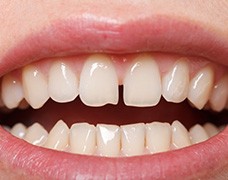
A person may have gaps between their teeth due to factors like the way their mouth and jawbones developed, having small teeth, prolonged thumb-sucking or pacifier use in childhood, and a variety of other causes. These gaps can allow large amounts of bacteria and food debris to accumulate between the teeth and leave the gum tissue more exposed to injury. Fixing these spaces between teeth is usually the best course of action, and while Invisalign is often the ideal solution, this issue can sometimes be corrected with dental bonding.
Overbite
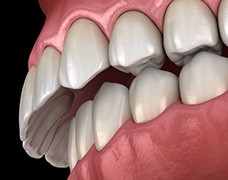
An overbite, also called an overjet, happens when the top teeth protrude too far in front of the lower teeth, and it can lead to jaw pain, speech problems, uneven dental wear, and discomfort when closing or opening the mouth. This issue can also make the top teeth more susceptible to injury by leaving them more exposed.
Underbite
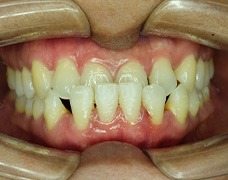
An underbite refers to when the bottom teeth match or protrude farther than the top teeth when the mouth is closed, and it is usually caused by oral trauma, genetic factors, or prolonged thumb or pacifier-sucking in early childhood. This misalignment can lead to a range of issues like an increased risk of sleep apnea, difficulty eating and speaking, and mouth breathing, and it is usually easier to address in younger patients. However, it’s still important to correct this issue in adults, and Invisalign treatment usually requires rubber bands or other attachments to adjust the lower teeth appropriately.
Crossbite
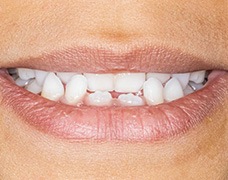
A crossbite happens when the bottom teeth are positioned slightly before the upper arch and is typically caused by bad oral habits, genetics, or the early loss of baby teeth. While Invisalign can usually fix this issue, the treatment may require accessories such as elastics to reposition the jaw. An unaddressed crossbite can lead to long-term problems like a greater risk of oral infections, jaw pain, speech issues, headaches, teeth grinding, facial asymmetry, and decreased confidence.
Open Bite
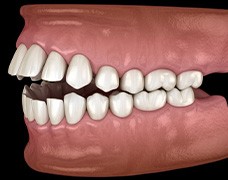
The top and bottom front teeth of a person with an open bite will not overlap or touch when the mouth is closed. Open bites are usually the result of poor bone development or non-nutritive habits such as thumb or pacifier-sucking continuing too long in childhood. This type of misalignment can make it difficult to speak clearly or lead to excessive wear on the back teeth, but Invisalign can correct this issue by moving the top and bottom front teeth into more optimal positions.
Benefits of Invisalign

The reason Invisalign is so highly recommended by patients and professionals alike is because the treatment offers several distinct advantages over traditional braces. Some of the benefits you’ll be able to enjoy while undergoing treatment include:
Discreet Aligners
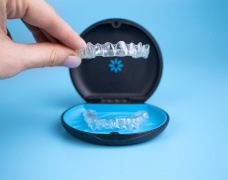
Of course, one of the most well-known perks of Invisalign is that the aligners are see-through. As a result, they don’t draw any unwanted attention. In other words, you can enjoy a metal-free smile from start to finish!
Easy Oral Care

Since Invisalign aligners are removable, you don’t need to adopt a time-consuming oral hygiene routine or buy special products, like interproximal toothbrushes. Instead, you can brush, floss, and rinse with mouthwash like normal.
No Changes to Your Diet

To prevent broken brackets and other orthodontic emergencies, patients with traditional braces need to steer clear of crunchy foods, even healthy ones like apples! Fortunately, that’s not the case with Invisalign; you can eat all of your favorites throughout your orthodontic treatment.
Shorter Average Treatment Timeline

If your case of malocclusion is mild, then you may only need to wear clear aligners for six months. Even if it’s more moderate, you’ll be happy to know that the average Invisalign treatment timeline is 12-18 months. Traditional braces, on the other hand, can take two years or more.
Fewer Progress Appointments

If you have a jam-packed schedule, the thought of adding monthly orthodontic treatments to the calendar might be overwhelming. The good news is that there are fewer progress appointments with Invisalign. They are typically every six or eight weeks instead of every four.
No Soft Tissue Irritation

Metal brackets and wires are effective and reliable, but they can irritate the soft tissue in your mouth. The good news is that Invisalign aligners are metal-free, custom-made from impressions of your teeth, and crafted from smooth, low-profile plastic, making them considerably more comfortable.
You Can Take The Aligners Off

Are you taking your senior photos soon? Maybe you have an important event, like your wedding or a meeting with a client, coming up. In that case, you can take your aligners off beforehand! Just make sure you put them back on as soon as you can to avoid falling too far behind on your wear time.
Boosted Confidence

One of the best parts of Invisalign is that you don’t have to worry about “metal mouth.” Between the fact that the aligners are see-through and you’ll start to see improvements relatively quickly, you’ll have countless reasons to smile throughout the teeth-straightening process!
Living with Invisalign Aligners
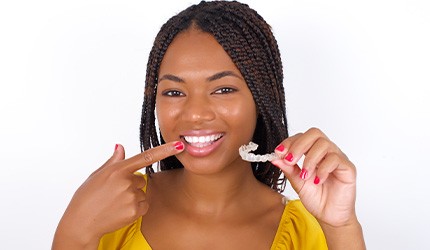
If you’re struggling with which orthodontic method is best for you, understanding what life looks like with Invisalign can help you make an informed decision. It’s normal to want to know how it might impact your daily routines, habits, and abilities. Continue reading to learn more about what you can expect once you begin treatment so you have a better idea of what to expect! If you have additional questions, feel free to contact us, and we’d be happy to assist you.
Wearing Your Trays
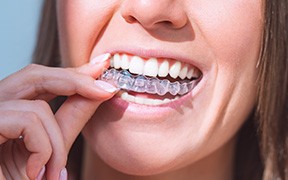
Your Invisalign trays cover your teeth to gently shift them to their ideal placements, but if you don’t wear them long enough daily, you might fall behind your treatment timeline. They must be worn 20 to 22 hours daily to prevent your pearly whites from shifting to their original positions. You might have to revert to previous trays (or have them reordered) to correct such a relapse, which can potentially set you back by several weeks.
If you’re struggling to wear your aligners long enough, you might try using an app that can help you track how long they’re in your mouth. You can also set timers for yourself, so you don’t forget to reinsert them after meals.
Cleaning Your Aligners
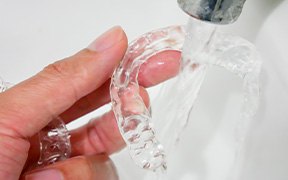
Bacteria in your mouth and leftover bits of food can become trapped in the space between your clear orthodontics and teeth. Unfortunately, because they’re pressed tightly together most of the day and night, this increases your risk of developing cavities and gum disease.
To prevent these oral issues, thoroughly wash your trays twice daily with a soft-bristled toothbrush and clear dish soap that won’t abrade the material. It’s also usually safe to soak them for 15 minutes daily with a special solution, like Invisalign Cleaning Crystals. Remember to avoid hot water that can warp the plastic, so it no longer fits!
Eating & Drinking

Patients with traditional braces must follow a long list of dietary restrictions to avoid damaging the brittle metal brackets and wires. Thankfully, that’s not the case with Invisalign because the trays are removable. You should take them out for meals, then rinse your mouth before reinserting them and continuing your day.
If you eat or drink anything besides water with your aligners inserted, you’re likely to harm or stain them, which defeats the purpose of “invisible” orthodontics.
Losing or Damaging a Tray
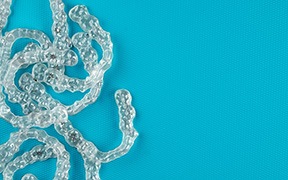
Because they’re frequently removed and replaced from your mouth, it’s not uncommon to accidentally misplace or damage the clear aligners. Whether you accidentally tossed it out with your napkin at lunch or put it in a pocket and sat on it afterward, missing or broken trays can potentially extend your treatment by several weeks.
Contact our team right away to let us know what happened. We’ll then let you know whether you should return to your old trays while we reorder yours or advance to the next series early.
Routine Check-Ins

Throughout your treatment, you can expect a follow-up appointment with our team every four to eight weeks to ensure that everything is still on track. Typically, these visits are as brief as 15 to 30 minutes. That’s all we need to examine your mouth, ensure that all is well, and provide your next few sets of trays to wear until your next check-in.
Understanding the Cost of Invisalign
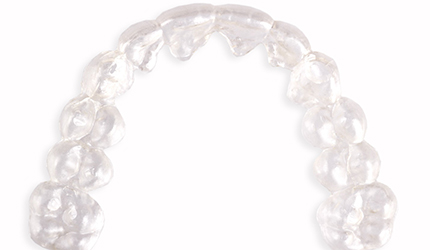
We will work with you to make sure that you can enjoy all the benefits of Invisalign without having to worry about the cost of the procedure breaking your monthly budget. While you may have attempted to find an estimate for the cost of the procedure online, the truth is that the only way to get a useful price range is to examine your mouth and determine your individual needs. Below, you can learn more about the factors that go into the overall cost of Invisalign as well as potential strategies for keeping your out-of-pocket costs under control.
Factors that Affect the Cost of Invisalign
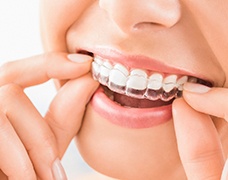
When we are putting together an estimate of the final price of Invisalign treatment, we’ll need to ask the following questions:
- How many arches need to be corrected? Most people wear Invisalign on both the upper and lower teeth. If only one arch needs to be corrected, then the cost of care will likely be lower than usual.
- How complex is the case? The more severe an issue is, the more costly it is to treat. It’s less expensive to bring two teeth closer together than it is to straighten the entire arch, for example.
- How long is the treatment expected to take? Every Invisalign aligner is worn for roughly two weeks; the longer the treatment, the more aligners will be required.
Invisalign vs. Smile Direct Club™: Which Costs More?

On average, the Smile Direct Club is less costly than Invisalign. However, when comparing any two orthodontic treatments, there is one phrase you should keep in mind: you get what you pay for. The trade off for the lower cost of the Smile Direct Club is that the responsibility of taking accurate impressions and making sure that the treatment goes as planned falls on you. As such, there’s a higher chance of problems occurring. But with Invisalign, an experienced dentist will personally handle and oversee the process to ensure that it all goes smoothly from start to finish.
Does Dental Insurance Cover Invisalign?
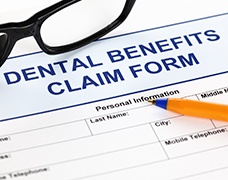
Invisalign falls under orthodontic treatment, but the question of whether it’s covered by insurance will have a different answer depending on who your carrier is. Some plans may not pay for orthodontic care at all while others only pay for treatments meant for children. Our team is used to working with a variety of insurance companies and will happily go over your plan with you to make sure you understand all the ins and outs.
Options for Making Invisalign Affordable

To save money on Invisalign, you can take advantage of our current special of $500 off treatment; this deal even includes a free consultation. Also, you can apply for CareCredit or LendingClub financing so that you can pay for your treatment in a series of installments instead of all at once. We can go over the details with you during your initial consultation.
Invisalign FAQs
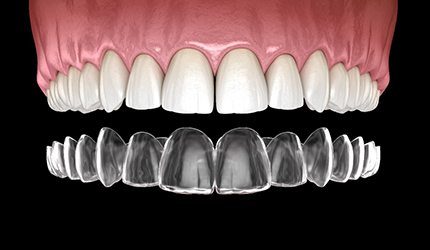
If you’re interested in Invisalign in DeSoto but aren’t completely familiar with the process, don’t worry; our team is always happy to answer questions! If there’s anything you want to know about how Invisalign works or what you can expect during the treatment, just let us know. Before you call, though, we encourage you to review the FAQs listed below. They cover some of the most common things that people ask about when looking into getting clear aligners.
How Long Will Invisalign Take?
It depends on what state your teeth are in – in other words, what kind of misalignment issues you have and how severe they are. Your commitment to the treatment plan is another factor, as not wearing your aligners as often as you should can extend the timeline. On average, Invisalign treatment is completed between 12 to 18 months, which is shorter than the average treatment time for braces. In cases where the misalignment is very mild, the treatment can even be as short as just 6 months. Make sure that you’re continuing to visit our office on a regular basis so that we can make sure that your treatment is still on track.
Does Invisalign Hurt?
Invisalign pushes the teeth towards a new, straighter alignment. This naturally means you’ll feel some pressure when you put in a new set of aligners. However, the treatment is not painful. The aligners are made out of a very smooth plastic that’s comfortable to wear, and any minor soreness or discomfort that occurs at first will fade as your mouth gets used to the treatment. If you need a little help staying comfortable while adjusting to new aligners, you can use over-the-counter medication or apply a cold compress to any sore areas. Some patients also benefit from drinking ice water.
What Happens If My Invisalign Breaks?
Invisalign aligners can sometimes break, crack, or get scratched. In the case of a hairline crack, you can still wear the aligner, but you need to exercise caution when taking it out of your mouth. At no point should you try to repair the aligners by yourself, especially if it involves super-glue or another potentially toxic substance. We recommend that you contact us immediately once you realize your Invisalign is damaged; we can advise you on next steps, like going back to a previous aligner in the series or switching to the next one a few days early.
Does Invisalign Give You a Lisp?
Invisalign can sometimes have a minor effect on your speech when you first start wearing it since it changes the proper placement of your tongue while speaking. This can cause some patients to develop a lisp, although others do not have this issue. In most cases, the lisp will simply go away after you’ve adjusted to Invisalign. You can practice speaking with Invisalign to get rid of your lisp sooner; the more you talk, the sooner your tongue will learn to move properly while the aligning trays are in your mouth.